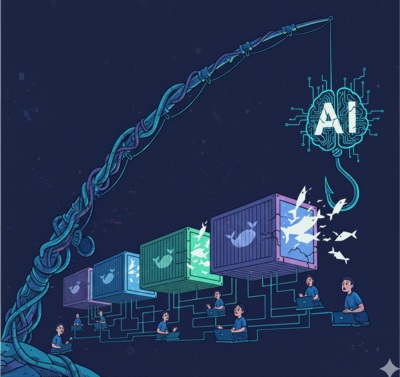| Why Dev Teams See AI Phishing Attacks as a Major Supply Chain Risk |
| Written by Jeff Broth | |||
| Monday, 24 November 2025 | |||
|
AI phishing is the use of generative technologies to create hyper-personalized, contextually accurate, and highly convincing social engineering attacks that compromise human credentials and trust. We look at what the risks are and provide some pointers for introducing controls and guardrails.
If your product ships through a modern pipeline, your “supply chain” now includes inboxes, identity providers, SaaS connectors, CI/CD, and the people who bridge them with approvals and credentials. This comes with inherent risks, however. Recent data shows the growing use of generative technologies in social engineering against even small businesses, which means a risk of a broader democratization of high-fidelity deception. Verizon’s 2025 Data Breach Investigations Report again ranks Social Engineering among the top breach patterns, alongside System Intrusion and Basic Web Application Attacks. This confirms that human-layer attacks sit shoulder-to-shoulder with software exploits in real incidents. Artificial intelligence (AI) is adding extra layers, such as scriptable attachments, which have lowered costs while raising their conversion rates, especially in multilingual and sector-specific spear-phishing. How AI phishing becomes a supply chain problemIn today’s stack, a convincing AI-crafted lure is not the incident. It is merely the first step in a chain that runs through identity, automation, and software provenance. In the DevOps context, AI phishing attacks are designed to gain durable access to trusted systems, including mail, source control, CI/CD, cloud consoles, and artifact registries. These let attackers read secrets, alter code or builds, and move laterally without noisy exploits. The primary assets at risk are session tokens and refresh tokens issued by the identity provider, OAuth consents that grant API access to “apps,” personal access tokens or workload credentials used by CI runners, signing keys and attestations tied to build provenance, and the content of private repositories and registries. The most common entry points are well-timed emails or chat messages that impersonate vendors, payroll, compliance, or internal IT; these now arrive in multiple languages and mimic house style, because large language models make personalization cheap. Once a target clicks, two frequent paths follow. In the consent-phishing path, the user is guided to authorize a seemingly legitimate application with broad scopes, giving the adversary API-level reach into mail, files, and calendars without ever seeing a password. In the credential-reuse path, the user is led to a branded credential harvester. Captured passwords are then combined with social engineering of the helpdesk to bypass multi-factor authentication or to initiate a password reset. The compromise becomes a supply chain event when identity access is used to tamper with software or its release mechanics. With mailbox access and source-control visibility, the attacker hunts for secrets, long-lived tokens, and deployment scripts. If repository permissions are sufficient, they might even attempt to push code or open seemingly benign pull requests that smuggle changes into build scripts. If CI/CD is reachable via tokens, they trigger pipelines, swap artifacts, or disable checks. If the organization signs artifacts, attackers then probe for gaps in enforcement, such as unsigned hotfix paths, missing attestations, or environments that accept artifacts without provenance. If those fail, they pivot to cloud through federated roles tied to CI or through service accounts discovered in code or docs. The blast radius depends on how strictly the org enforces least privilege, short-lived credentials, and provenance-gated promotion. Where defenses are weak, a single phish can cascade: mail to repo, repo to CI, CI to registry, registry to production, and onward to customers consuming tainted packages. How dev teams can build controls and guardrailsDefenders should therefore model three control planes and their failure modes. In the identity plane, the goal is to prevent durable access by constraining consents to verified publishers, limiting scopes, enforcing step-up authentication for sensitive actions, and automatically revoking sessions upon risk signals, such as mailbox-rule anomalies or impossible travel. In the pipeline plane, the goal is to ensure that even valid credentials cannot deliver untrusted code. Require signed commits and artifacts, verify build attestations, and block promotion when provenance is missing or altered. In the content plane, the goal is to stop active content from reaching users or sandbox it safely. Treat SVG/HTML attachments as executable, follow data-URI redirects in analysis, and isolate previewers. Govern consent and sessions as code Treat mail ingress like an API gateway Use policy to remove “legacy exceptions.”Collect inbox telemetry, such as auth results, redirect chains, and user-report timings, and make them observable alongside app metrics. Neutralize stolen tokens with provenance and policy One upstream compromise can cascade through dependency graphs. For instance, the attempted XZ Utils supply chain attack almost cascaded backdoor access across Linux-based devices worldwide, had it succeeded. Rotate secrets automatically, prefer short-lived credentials, and prevent access when signatures or SBOM/attestations do not match expected policy. This ensures that even if a phish is successful, it does not give attackers production control. Harden support workflows and bots as first-contact sensors Set ethical simulation guardrails and publish them From “people problem” to engineering disciplineAI phishing is not “just email.” It can be an entry point into your software supply chain where identity, automation, and provenance converge. If you focus on revocation speed, provenance-gated deploys, constrained consent, and attachment isolation, a successful lure should yield only short-lived access and automatic rollback, not a production incident. Keep your metrics simple and public to your teams: time to revoke, percentage of signed releases, DMARC enforcement coverage, and policy-gated promotions. This converts a “people problem” into an engineering discipline that dev teams can own. Related ArticlesInsights Into Software Supply Chain Security To be informed about new articles on I Programmer, sign up for our weekly newsletter, subscribe to the RSS feed and follow us on Twitter, Facebook or Linkedin.
Comments
or email your comment to: comments@i-programmer.info
|
|||
| Last Updated ( Tuesday, 25 November 2025 ) |



